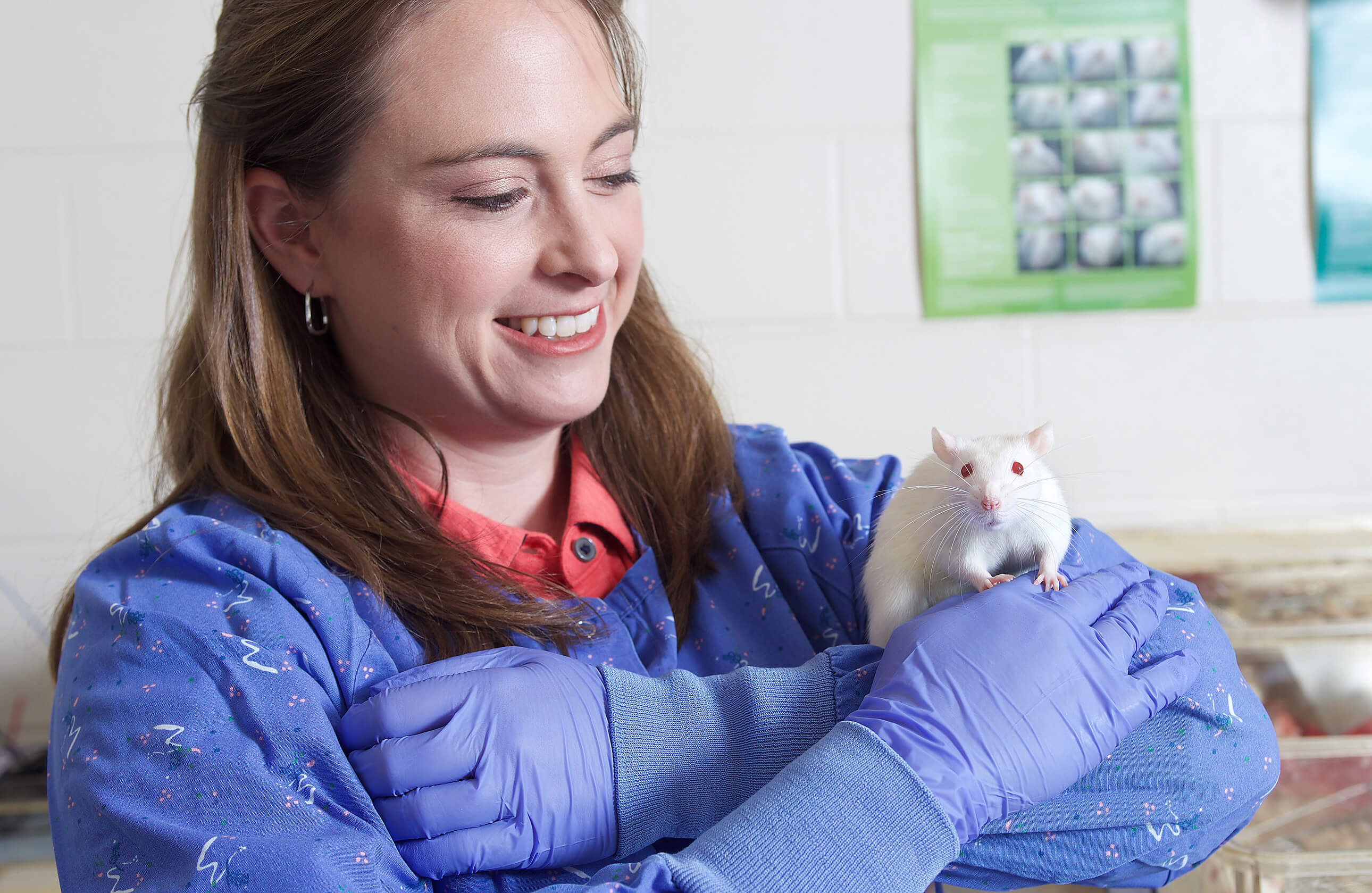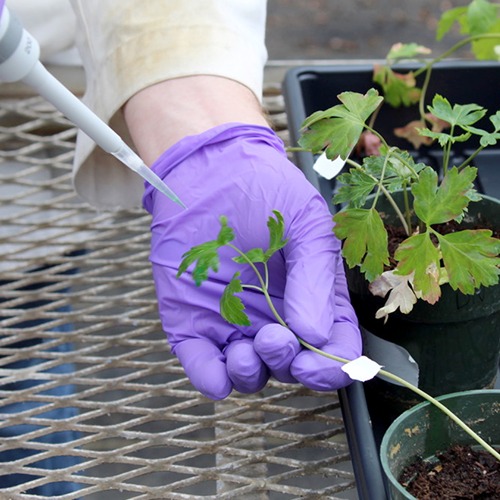Parents often use tickling as a playful way to lighten a child’s mood. In Brianna Gaskill’s Purdue University lab, scientists do the same thing, only with rats.
Gaskill, an assistant professor in the Department of Animal Sciences and a member of Purdue’s Center for Animal Welfare Science, champions so-called rat “tickling” as a way to improve the quality of life for laboratory rats. Making brisk dorsal contact around the animal’s shoulder blades with their fingertips, and then flipping the rat over and pinning it, researchers simulate the way rats play with each other. While it’s not technically tickling, the quick finger movements look similar.
“The movements do look like tickling, but we’re mimicking social play. You’re not actually tickling them like you would a little kid,” Gaskill said. “We want to get lab animal personnel to create a lower-stress environment and for the rats to express more positive emotions, especially when handled by humans. These tickling techniques accomplish that, if done correctly.”
Gaskill, Megan LaFollette, a graduate student in Gaskill’s lab, and colleagues describe the proper techniques for rat tickling in a paper published in the Journal of Visualized Experiments. They argue that rats used for research in laboratories or kept as pets can show physiological and behavioral signs of physical and emotional stress. That can lead to difficulty handling the rats, reduced rat well-being and potentially inaccurate research results.
Researchers can measure the pleasure tickling derives through monitored behavior, but also through ultrasonic vocalizations rats make that can only be heard with sensitive audio equipment. Rats making 22-kHz sounds are stressed or fearful and often make the sounds when exposed to predators, experiencing pain and during fights. Improper handling techniques can also lead to these negative vocalizations.
But rats making 50-kHz sounds are happy. They emit these sounds when playing with each other, when given treats and when engaged in proper tickling.
Proper techniques, described in Gaskill and LaFollette’s findings, include preparing the rat’s home or cage by using appropriate bedding and removing obstacles for safe play; moving one hand confidently and briskly during flips and pins; and tickling in bouts of 15 seconds at a time.
“We want people to use it, but we want them to use it the right way,” Gaskill said. “If you’re working with rats, this is something you can do to reduce stress. But improper technique can have the opposite effect, increasing fear and stress.”
Proper tickling has been shown to make handling of rats easier, improve how quickly rats approach a human and increase positive vocalizations, as described in another paper by LaFollette and Gaskill. Tickled rats that are given injections for research purposes make fewer negative audible noises and more positive ultrasonic vocalizations before and after injections.
In another tickling research project, LaFollette tested tickling on pet-store rats. Some rats received no tickling, while the tickled rats were divided into two groups based on how many positive vocalizations were made during tickling.
All rats that were tickled were easier to restrain and spent more time outside their huts than the control rats. Only the rats that made fewer positive vocalizations during tickling – possibly a sign that these rats have higher general anxiety and depression – showed more fear and anxiety than the controls.
The results suggest that tickling can be used as a method to determine which rats might make better pets and to improve socialization of all rats before they’re sold to new owners.
“Pet rats will interact with humans even longer than those kept in labs,” said LaFollette, whose findings were published in Applied Animal Behaviour Science. “This gets us a step closer to improving the welfare of these rats.”
The Animal Welfare Institute, the American Association for Laboratory Animal Science and Petco Animal Supplies supported this research.
Researchers can measure the pleasure tickling derives through monitored behavior, but also through ultrasonic vocalizations rats make that can only be heard with sensitive audio equipment. Rats making 22-kHz sounds are stressed or fearful and often make the sounds when exposed to predators, experiencing pain and during fights. Improper handling techniques can also lead to these negative vocalizations.
But rats making 50-kHz sounds are happy. They emit these sounds when playing with each other, when given treats and when engaged in proper tickling.
Proper techniques, described in Gaskill and LaFollette’s findings, include preparing the rat’s home or cage by using appropriate bedding and removing obstacles for safe play; moving one hand confidently and briskly during flips and pins; and tickling in bouts of 15 seconds at a time.
“We want people to use it, but we want them to use it the right way,” Gaskill said. “If you’re working with rats, this is something you can do to reduce stress. But improper technique can have the opposite effect, increasing fear and stress.”
Proper tickling has been shown to make handling of rats easier, improve how quickly rats approach a human and increase positive vocalizations, as described in another paper by LaFollette and Gaskill. Tickled rats that are given injections for research purposes make fewer negative audible noises and more positive ultrasonic vocalizations before and after injections.
In another tickling research project, LaFollette tested tickling on pet-store rats. Some rats received no tickling, while the tickled rats were divided into two groups based on how many positive vocalizations were made during tickling.
All rats that were tickled were easier to restrain and spent more time outside their huts than the control rats. Only the rats that made fewer positive vocalizations during tickling – possibly a sign that these rats have higher general anxiety and depression – showed more fear and anxiety than the controls.
The results suggest that tickling can be used as a method to determine which rats might make better pets and to improve socialization of all rats before they’re sold to new owners.
“Pet rats will interact with humans even longer than those kept in labs,” said LaFollette, whose findings were published in Applied Animal Behaviour Science. “This gets us a step closer to improving the welfare of these rats.”
The Animal Welfare Institute, the American Association for Laboratory Animal Science and Petco Animal Supplies supported this research.






